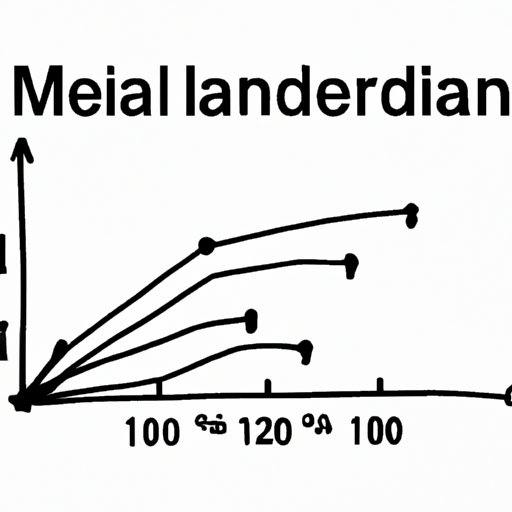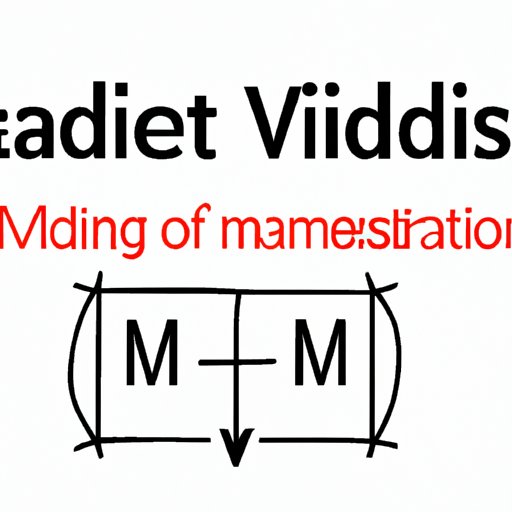
I. Introduction
The median is a common term used in statistical analysis. It represents the middle value of a given dataset when arranged in order of magnitude. Understanding the median is crucial in various fields such as finance, healthcare, and social sciences, as it provides valuable insights into the data. In this article, we will explore the significance of the median, how to calculate it accurately, and its applications.
II. Calculating the Median: Simple Steps for Finding the Middle Value
Calculating the median is a straightforward process when the dataset is arranged in order of magnitude. When the set has an odd number of values, the median is the middle value. When the set has an even number of values, the median is the average of the two middle values.
A. Explanation of how to find the median when there is an odd number of values
For example, consider the data set {2, 3, 4, 5, 6}. The middle value is 4. Hence, the median is 4.
B. Explanation of how to find the median when there is an even number of values
For example, consider the data set {2, 3, 4, 5, 6, 7}. The middle values are 4 and 5. The average of 4 and 5 is 4.5. Hence, the median is 4.5.
C. Examples and practice problems
Examples and practice problems help to solidify one’s understanding of the material. The following are examples of finding the median in different datasets.
Example 1: {3, 2, 5, 1, 4} Find the median.
Solution: Arrange the values in order of magnitude: {1, 2, 3, 4, 5}. The middle value is 3. Hence, the median is 3.
Example 2: {6, 5, 7, 4, 8, 9} Find the median.
Solution: Arrange the values in order of magnitude: {4, 5, 6, 7, 8, 9}. The middle values are 6 and 7. The average of 6 and 7 is 6.5. Hence, the median is 6.5.
III. Understanding and Using the Median: An Essential Skill in Statistics
The median is an essential measure in statistics because it provides information on the central tendency of the data. The central tendency is a measure of the average or typical value of the data. It is used to identify the most representative value or values and make measurements significant.
A. Importance of using the median in statistical analysis
The median is often preferred over other measures of central tendency in situations where outliers (extreme values) are present in the data. Outliers can significantly affect the mean, making it an unsuitable measure for data analysis. The median, on the other hand, is robust to outliers and provides a more realistic depiction of the data’s central tendency.
B. Comparison with other measures of central tendency (i.e., mean and mode)
The mean is another measure of central tendency that is widely used in statistics. Unlike the median, the mean takes into account all values in the dataset. The mode is the value that appears most frequently in the dataset.
C. Real-world examples of where the median is used
The median is used in many different fields, including healthcare, finance, and social sciences. In healthcare, it is used to describe the distribution of patient outcomes, such as length of hospital stay or the time it takes for an individual to recover from a disease. In finance, it is used to measure the central tendency of stock prices, interest rates, and other economic indicators. In the social sciences, it is used to gauge the income distribution and measure the poverty level in a particular population.
IV. From Raw Data to Median Values: A Comprehensive Guide
Calculating the median from raw data involves several steps. The following section discusses these steps and includes a discussion on how to handle outliers.
A. Explanation of how to calculate the median from raw data
The first step is to arrange the data in order of magnitude. Then, find the middle value(s). If there is an odd number of values, the median is the middle value. If there is an even number of values, the median is the average of the two middle values.
B. Discussion of how to handle outliers
Outliers can significantly affect the median and the central tendency of the data. There are different methods to handle outliers, such as removing them from the dataset or assigning them a specific value. However, the method chosen depends on the context and the research question.
C. Examples and practice problems
Example 1: Calculate the median of the following dataset: {7, 3, 4, 1, 9, 5}
Solution: Arrange the values in order of magnitude: {1, 3, 4, 5, 7, 9}. The middle value is 5. Hence, the median is 5.
Example 2: Calculate the median of the following dataset: {2, 5, 7, 11, 12, 15}
Solution: Arrange the values in order of magnitude: {2, 5, 7, 11, 12, 15}. The middle values are 7 and 11. The average of 7 and 11 is 9. Hence, the median is 9.

V. Mastering the Art of Median Calculation: Tips and Tricks
Calculating the median can be a bit tricky, especially with a large dataset. Here are some tips and tricks for mastering the art of median calculation:
A. Best practices for calculating the median accurately
It is essential to be consistent in following the steps for calculating the median. Arrange the data in order of magnitude, and determine the middle value(s) accurately. Double-check your work to ensure accuracy.
B. Strategies for calculating the median quickly
For larger datasets, it may be helpful to group the values into intervals or use the median formula. The median formula is (n + 1) / 2, where n is the number of values in the dataset.
C. Common mistakes to avoid
Common mistakes when calculating the median include confusing it with the mode and mean, not arranging the data in order of magnitude, and incorrect arithmetic when computing the median with an even number of values.
VI. Why Finding the Median Matters: Uses and Applications
The median is a valuable measure that provides insights into the central tendency of the data. It is used in many different fields such as finance, healthcare, and social sciences.
A. Discussion of how the median is used in various fields (e.g., finance, healthcare, social sciences)
In finance, the median is used to measure the central tendency of economic indicators such as stock prices and interest rates. In healthcare, it is used to describe the distribution of patient outcomes, such as length of hospital stay or time to recovery. In social sciences, it is used to gauge income distribution and measure poverty levels in particular populations.
B. Explanation of how the median reveals insights about the data
The median provides insights into the central tendency of the data, which can be essential in making informed decisions. It is particularly valuable when outliers are present in the dataset.
C. Examples and case studies
Example: A study on the salaries of employees in a company. The median salary is used to represent the central tendency of the salaries. It provides a better representation of the salaries than the mean, as there may be a few employees with exceptionally high or low salaries that skew the mean.
VII. Discovering the Central Tendency: Exploring the Mean and Median
The mean and median are two common measures of central tendency. They are used to identify the most representative value or values of the data.
A. Comparative analysis of mean and median
The mean and median are often different measures. The mean is more sensitive to extreme values, whereas the median is relatively robust to outliers.
B. Advantages and disadvantages of mean and median
The mean is used when analyzing numerical values. It is a more precise measure of the central tendency of the data. However, the mean can be significantly affected by outliers. The median is a better measure when the data includes extreme values that could distort the mean.
C. When to use mean vs. median
The choice between using the mean and median depends on the context and the research question. The mean is preferred when extreme values are not present in the dataset. However, if outliers are present, the median may be a better representation of the central tendency of the data.
VIII. Conclusion
The median is a valuable measure in statistics that provides insights into the central tendency of the data. It is often preferred over other measures of central tendency when outliers are present in the dataset. Calculating the median accurately is a fundamental skill in data analysis, and it is helpful to know the best practices for finding the median. By understanding the significance of the median and its applications, one can make informed decisions in a variety of fields.
Takeaway: Calculating the median is an essential skill in understanding the central tendency of data. It is a valuable measure in various fields and is often preferred over other measures when outliers are present. Understanding how to find the median and when to use it provides valuable insights into the data.





